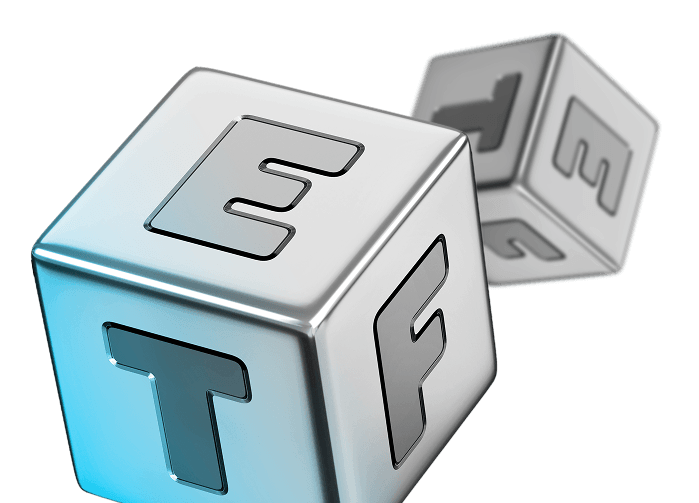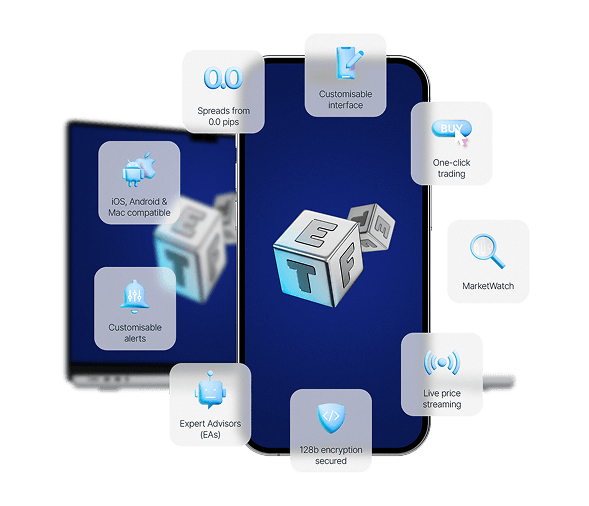
ETF CFD trading
Trade over 300 CFDs on Exchange Traded Funds (ETFs) and diversify your investing across stock, index, and sector markets in a single trade.
What is an ETF?
An Exchange-Traded Fund (ETF) is an investment fund that holds a collection of assets – like shares, bonds, or commodities – and is traded on a stock exchange just like a regular stock. An ETF is a way to invest in a wide range of financial assets at the same time, assisting in portfolio diversification without having to buy each asset individually. Investors can earn a return if the value of ETF investments surges or if the ETF pays a dividend.
ETFs pool together money from investors into a basket of different investments. This way, an ETF’s performance can reflect the trajectory of a part of the market. Many traders consider ETFs an option for portfolio diversification. The level of diversification an ETF provides depends on the index it tracks.
Mutual funds such as The Vanguard Group, Commonwealth Funds, Morningstar, and BlackRock manage ETFs that are popular among investors in global markets. According to latest market data reports, the ETF industry grew substantially in 2024, with a record US$14.8 trillion assets under management (AUM).

A brief history of ETF trading
ETF trading began in Canada in 1990 with the launch of the Toronto Index Participation Fund, following the stock market crash of 1987, which sparked interest in flexible investment vehicles. Physicist Nate Most, working for the American Stock Exchange (AMEX), was commissioned to develop a new type of asset. He designed the structure for the first US-based Exchange Traded Fund (ETF), aiming to provide investors with a cost-effective and diversified product.
ETFs helped institutional investors execute sophisticated trading strategies more efficiently. They introduced the broader market to pooled investing and trading flexibility. Standard & Poor's Depositary Receipts (SPDR), widely known by its ticker SPY and launched in 1993, remains the world’s most heavily traded ETF, with over US$400 billion in assets under management (AUM).
Different types of ETFs

Investor demand and technological progress have played a major role in the increase of ETFs, with the number surpassing 8,000 worldwide. ETFs have drawn the attention of investors seeking to grow their capital without engaging in time consuming asset research.
There are various types of ETFs. Some ETFs invest in a variety of stocks and bonds; others track the performance of a stock index, like the Standard and Poor’s E-Mini Index (S&P 500 E-Mini) or the E-Mini (CBOT) Dow Jones Industrial Average (DJIA), while some track the market performance (IBM Index).
Bond ETFs
Bond ETFs (commonly known as Fixed Income ETFs) are designed to provide exposure to a wide range of available bonds, including US Treasury Bonds, corporate and municipal bonds (munis), international bonds, high-yield bonds, etc.
Bond ETFs are considered lower risk investments when compared to Equity ETFs. Retail investors who are looking for income diversification and institutional investors, such as pension and hedge funds, are two groups that are likely to invest in Bond ETFs.
Commodity ETFs
Commodity ETFs track the price of a specific commodity, such as Gold (XAU), Silver (XAG), Oil (XBR, XTI), or a basket of commodities.
Institutional investors use Commodity ETFs for hedging, while retail investors invest in them, seeking exposure to commodities without trading futures or physical goods.
Physically backed gold ETFs
Gold ETFs are one way of investing in gold. This type of ETF holds gold bullion as its underlying asset. Gold ETFs allow investors to make use of gold price fluctuations without having to store or insure quantities of the precious metal. Gold ETFs can be bought and sold at any time of the day, as long as stock exchanges are open. ETFs physically backed by gold typically don’t pay dividends as gold is a non-yielding asset. Investor returns can come from gold’s price appreciation.
Gold mining ETFs
Gold mining ETFs get you exposure to companies that mine and produce gold. Investing in gold mining is generally seen as a long-term investment.
The performance of Gold mining ETFs depends not only on gold prices, but also on mining companies’ fundamentals, costs, growth plans, and stock market conditions.
Currency ETFs
Currency ETFs are exchange-traded funds that provide exposure to the value of a specific currency, such as the US dollar (USD); however, there are others that track multi-currency indices. Some Currency ETFs are physically backed, while others are based on derivatives like futures or swaps.
As a hedging option, a Currency ETF can help protect traders against adverse moves in forex rates.
Equity ETFs
Equity ETFs are exchange traded funds that invest in shares; they may track a specific stock index, sector or even a specific strategy. Investors use equity ETFs to gain exposure to a wide range of shares in a single trade, while they are considered ideal for individuals who would like to customise their financial plans.
Actively managed ETFs
Actively managed ETFs are overseen by portfolio managers who select assets and adjust positions to achieve a specific target. Depending on the goal, actively managed ETFs can invest in a mix of different assets.
Alternative investment ETFs
Alternative investment ETFs are innovative structures that enable traders to invest in non-traditional assets or gain exposure to investment strategies such as call writing and currency carry.
Exchange-Traded Notes (ETNs)
Exchange-Traded Notes (ETNs) are unsecured debt securities issued by creditworthy banks that track returns of underlying financial assets or indexes. ETNs typically have a set maturity date just like bonds.
Foreign market ETFs
Foreign market ETFs (also called International or Global ETFs) provide exposure to equities or assets in foreign countries. The most popular Foreign Market ETFs are the ones that follow foreign stock indices such as the Hang Seng, S&P/ASX 200, Nikkei etc.
Factor ETFs
Factor ETFs are based on specific characteristics (factors) related to returns, performance, and risk levels. Some of the factors are value, market cap, volatility, momentum etc. Tracking errors and factor performance cycles should be taken into consideration before investing in Factor ETFs.
Leveraged ETFs
A Leveraged ETF’s target is to amplify the daily return of the underlying asset, whether it is an index, sector or any other financial instrument. Derivatives like swaps and futures are used to multiply gains.
Inverse ETFs
Inverse ETFs are designed to deliver the opposite of the daily return of a specific asset or index. Inverse funds may go up when the target index depreciates; for instance, when traders short-selling a stock due to stock price depreciation. Inverse ETFs allow traders to trade on falling markets without the need to short stocks directly.
Sector and industry ETFs
Sector and industry ETFs are designed to provide exposure to particular industries, such as oil, pharmaceutical, and tech companies, etc.
Market ETFs
Market ETFs are funds that aim to track the performance of a stock market index like the SPY.ARC (Standard & Poor’s 500), and the STW.AXW (Australia 200 Index Cash).
Style ETFs
Style ETFs focus on investment styles like value or growth, regardless of market capitalisation (large-cap, medium-cap, small-cap).
Specialty ETFs
Specialty ETFs are funds that target specific market segments that may not fit traditional sector classifications. For example, in recent years, Specialty ETFs have provided exposure to the Artificial Intelligence (AI), cybersecurity, and clean energy industries to name a few.
Sustainable ETFs
Sustainable ETF (also called ESG ETFs) trading involves investing in firms that are in line with specific environmental, social and governance (ESG) criteria.
ESG ETFs favour companies applying sustainability practices, while underweighting business sectors such as energy or defence.
How does ETF CFD trading work?
An ETF (exchange-traded fund) is a type of investment fund traders buy or sell through a brokerage firm on the stock exchange. In ETF investing, traders do not have to acquire the underlying investment product physically. ETFs are popular financial instruments combining the diversification of mutual funds with the trading flexibility of stocks. ETFs pull together capital from both long-term investors and short-term traders into a basket of various investments, including stocks, bonds, and other security assets.
ETFs work in a similar way to stock trading. ETF issuers, such as financial institutions or fund managers, create funds to track the underlying assets’ performance and sell shares to investors participating in the fund. Thus, shareholders own a percentage of the ETF and not the underlying asset included in the fund.
ETF CFD trading allows traders to speculate on the price movements of an ETF without actually owning it. Instead of buying the ETF itself, traders use a contract for difference (CFD) to profit from price changes in either direction—rising or falling. This type of trading often involves leverage, meaning traders can control a larger position with a smaller amount of capital, but it also increases the risk of losses. ETF CFD trading is commonly used by active traders looking to capitalize on short-term market movements.
How to trade CFDs on ETFs?
There are several CFD ETF trading strategies investors and traders can use since ETFs allow trading different investment classes and various sectors.
Dollar-cost averaging
- Basic strategy.
- Buying a set fixed-dollar amount of an asset on a regular schedule.
- Appropriate for beginner investors.
- Suited for people who can set aside a small portion of their salary each month.
- Alternative to investing in a low-interest saving account.
- Dollar-cost averaging imparts discipline to the savings process. You can pay yourself first, which you achieve by saving regularly.
- Accumulate more units when the ETF CFD price is low and fewer units when the ETF CFD price is high, thus averaging out the cost of holdings.
Asset allocation
- Allocating a portion of a portfolio to different asset categories for diversification.
- Some ETF CFDs can be purchased with a small initial investment, making them accessible to new investors.
- Suited for beginners starting out, depending on investment horizon and risk tolerance.
Swing trading
- Aims to gain from price swings in ETF CFDs over a few days to a few weeks.
- Helps in portfolio diversification.
- Some CFDs on ETFs have tight bid/ask spreads, making them suitable for short-term trading.
- Suitable for technical inclined traders who use technical analysis to identify entry and exit points in trades.
Sector rotation
- Focusses on different sectors of the economy.
- Traders rotate into sectors expected to outperform and exit the ones underperforming.
- Risk management tool.
For example, an investor holding a Gold ETF CFD (e.g.,SPDR Gold Shares ETF; ticker GLD) may sell it after a strong performance and rotate into a Technology ETF (e.g., XLK) if they anticipate growth in the tech sector.
CFDs on physically backed ETFs
- ETFs are backed by a tangible asset like gold bullion or other commodities.
- Gold ETFs can be used as a hedge against inflation, US dollar depreciation or stock market volatility.
- Price movements follow spot market fluctuations.
- Offers exposure to metals and commodities without needing to store them.
Betting on seasonal trends
Traders use historical data to identify time periods where certain instruments tend to outperform or underperform.
Instead of buying individual stocks or commodities, traders can use CFDs on ETFs to gain exposure to financial sectors or assets affected by seasonal patterns.
Hedging
Traders often invest in ETF CFDs to hedge and protect other positions against downside risks.
ETF CFD list
| Symbol | Description | Contract Size | Leverage |
|---|---|---|---|
| ACWI | iShares MSCI ACWI ETF (ACWI.xnms) | 1 | 1:5 |
| AGG | iShares Core U.S. Aggregate Bond ETF (AGG.arcx) | 1 | 1:5 |
| BIL | SPDR Bloomberg 1-3 Month T-Bill ETF (BIL.arcx) | 1 | 1:5 |
| BND | Vanguard Total Bond Market ETF (BND.xnms) | 1 | 1:5 |
| BSV | Vanguard Short-Term Bond ETF (BSV.arcx) | 1 | 1:5 |
| DIA | SPDR DJIA ETF (DIA.arcx) | 1 | 1:5 |
| EEM | iShares MSCI Emerging Markets ETF (EEM.arcx) | 1 | 1:5 |
| EFA | iShares MSCI EAFE ETF (EFA.arcx) | 1 | 1:5 |
| GLD | SPDR Gold Shares ETF (GLD.arcx) | 1 | 1:5 |
| HYG | iShares iBoxx High Yield Corp Bond ETF (HYG.arcx) | 1 | 1:5 |
| ICLN | iShares Global Clean Energy ETF (ICLN.xnms) | 1 | 1:5 |
| IEI | iShares 3-7 Year Treasury Bond ETF (IEI.xnms) | 1 | 1:5 |
| IEMG | iShares Core MSCI Emerging Mkts ETF (IEMG.arcx) | 1 | 1:5 |
| IJH | iShares Core S&P Mid-Cap ETF (IJH.arcx) | 1 | 1:5 |
| IJR | iShares Core S&P Small-Cap ETF (IJR.arcx) | 1 | 1:5 |
| ITOT | iShares Core S&P Total US Stocks ETF (ITOT.arcx) | 1 | 1:5 |
| IVV | iShares Core S&P 500 ETF (IVV.arcx) | 1 | 1:5 |
| IVW | iShares S&P 500 Growth ETF (IVW.arcx) | 1 | 1:5 |
| IWD | iShares Russell 1000 Value ETF (IWD.arcx) | 1 | 1:5 |
| IWF | iShares Russell 1000 Growth ETF (IWF.arcx) | 1 | 1:5 |
| IWM | iShares Russell 2000 ETF (IWM.arcx) | 1 | 1:5 |
| LQD | iShares iBoxx IG Corp Bond ETF (LQD.arcx) | 1 | 1:5 |
| QQQ | Invesco QQQ Trust Series 1 ETF (QQQ.xnms) | 1 | 1:5 |
| SHV | iShares Short Treasury Bond ETF (SHV.xnms) | 1 | 1:5 |
| SHY | iShares 1-3 Year Treasury Bond ETF (SHY.xnms) | 1 | 1:5 |
| SPY | SPDR S&P 500 ETF (SPY.arcx) | 1 | 1:5 |
| SUSL | iShares ESG MSCI USA Leaders ETF (SUSL.xnms) | 1 | 1:5 |
| TIP | iShares TIPS Bond ETF (TIP.arcx) | 1 | 1:5 |
| TLT | iShares 20+ Year Treasury Bond ETF (TLT.xnms) | 1 | 1:5 |
| TQQQ | ProShares UltraPro QQQ ETF (TQQQ.xnms) | 1 | 1:5 |
| VB | Vanguard Small-Cap ETF (VB.arcx) | 1 | 1:5 |
| VCIT | Vanguard Intermediate-Term Corporate ETF (VCIT.xnms) | 1 | 1:5 |
| VCSH | Vanguard Short-Term Corp Bond ETF (VCSH.xnms) | 1 | 1:5 |
| VEA | Vanguard FTSE Developed Mkts ETF (VEA.arcx) | 1 | 1:5 |
| VGT | Vanguard Info Tech ETF (VGT.arcx) | 1 | 1:5 |
| VIG | Vanguard Dividend Appreciation ETF (VIG.arcx) | 1 | 1:5 |
| VNQ | Vanguard Real Estate ETF (VNQ.arcx) | 1 | 1:5 |
| VO | Vanguard Mid-Cap ETF (VO.arcx) | 1 | 1:5 |
| VOO | Vanguard S&P 500 ETF (VOO.arcx) | 1 | 1:5 |
| VTI | Vanguard Total Stock Mkt ETF (VTI.arcx) | 1 | 1:5 |
| VTV | Vanguard Value ETF (VTV.arcx) | 1 | 1:5 |
| VWO | Vanguard FTSE Emerging Mkts ETF (VWO.arcx) | 1 | 1:5 |
| VXUS | Vanguard Total International Stock ETF (VXUS.xnms) | 1 | 1:5 |
| VYM | Vanguard High Dividend Yield ETF (VYM.arcx) | 1 | 1:5 |
| XLF | Financial Select Sector SPDR ETF (XLF.arcx) | 1 | 1:5 |
| XLK | Technology Select Sector SPDR ETF (XLK.arcx) | 1 | 1:5 |
ETF CFD trading - FAQs
What is an ETF?
An ETF (Exchange-Traded Fund) is a type of investment fund that is traded on a stock exchange. ETFs are passive or, sometimes, active investment products that track the performance of underlying financial assets.
In ETF investing, investors own units of the fund, so they do not have to acquire the investment product physically. ETFs are popular financial instruments combining the diversification of mutual funds with the flexibility of shares. ETFs pull together capital from investors into a basket of various investments, including stocks, bonds, and other asset classes.
How to trade ETF CFDs?
ETF CFD trading can be an effective way to access financial markets without directly owning the underlying ETFs. With ETF CFDs (contracts for difference), traders speculate on the price movements of exchange-traded funds—whether prices rise or fall. This form of trading is popular among short-term and active traders due to its flexibility and use of leverage.
There are several ETF CFD trading strategies that traders can use, as CFDs provide exposure to different asset classes and industry sectors. Traders should have a well-prepared trading plan and carefully choose the ETFs they want to trade based on their market view and risk tolerance.
ETF CFDs allow traders to implement various strategies to make use of market opportunities, manage risk, or diversify short-term positions. These strategies include trading on volatility, using seasonal trends tied to supply and demand, rotating between sectors, or even tapping into market downturns with inverse ETF CFDs. Since ETF CFDs can be traded both long and short, they offer a dynamic way to engage with global markets through a single platform.

